Last season was one that Brighton & Hove Albion fans will not forget about anytime soon.
After an excellent start to the season under Graham Potter, the Englishman left the club to join Chelsea, leaving the Seagulls without a head coach only a month into the new season.
However, Brighton moved quickly to replace him, bringing in former Sassuolo and Shakhtar Donetsk manager Roberto De Zerbi.
From a tactical perspective, De Zerbi brought a slightly different approach to what Potter had done, though still with a possession-oriented style of play.
The Italian tactician had a slow start to life on the south coast, with the club winless in his first five league matches.
However, that form turned around quickly, with Brighton going from strength-to-strength to finish sixth in the Premier League, qualifying for Europe for the first time in their history, with the club entering the UEFA Europa League group stages for the 2023/24 season.
Much of this success came down to Brighton’s goalscoring rather than their ability to keep goals out on the other end.
In fact, the south coast side finished with 72 goals scored on an xG of 62.43, showing a slight overperformance.
From a defensive standpoint, the Seagulls conceded 53 goals, the most in the top seven, against an xGA of 60.34, another overperformance.
For De Zerbi, the challenge will be replicating this success in this upcoming campaign, with Europa League football also on the agenda.
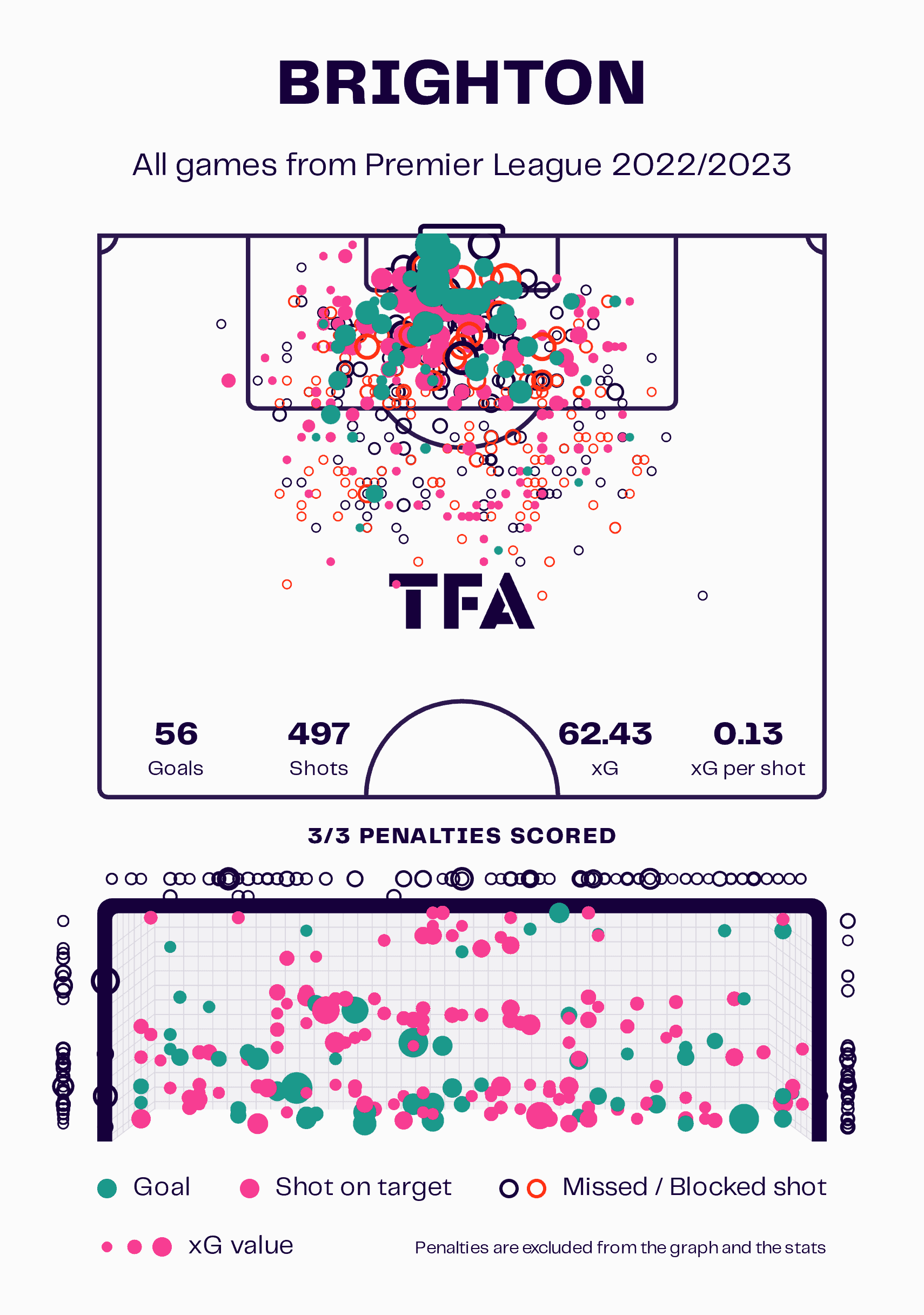
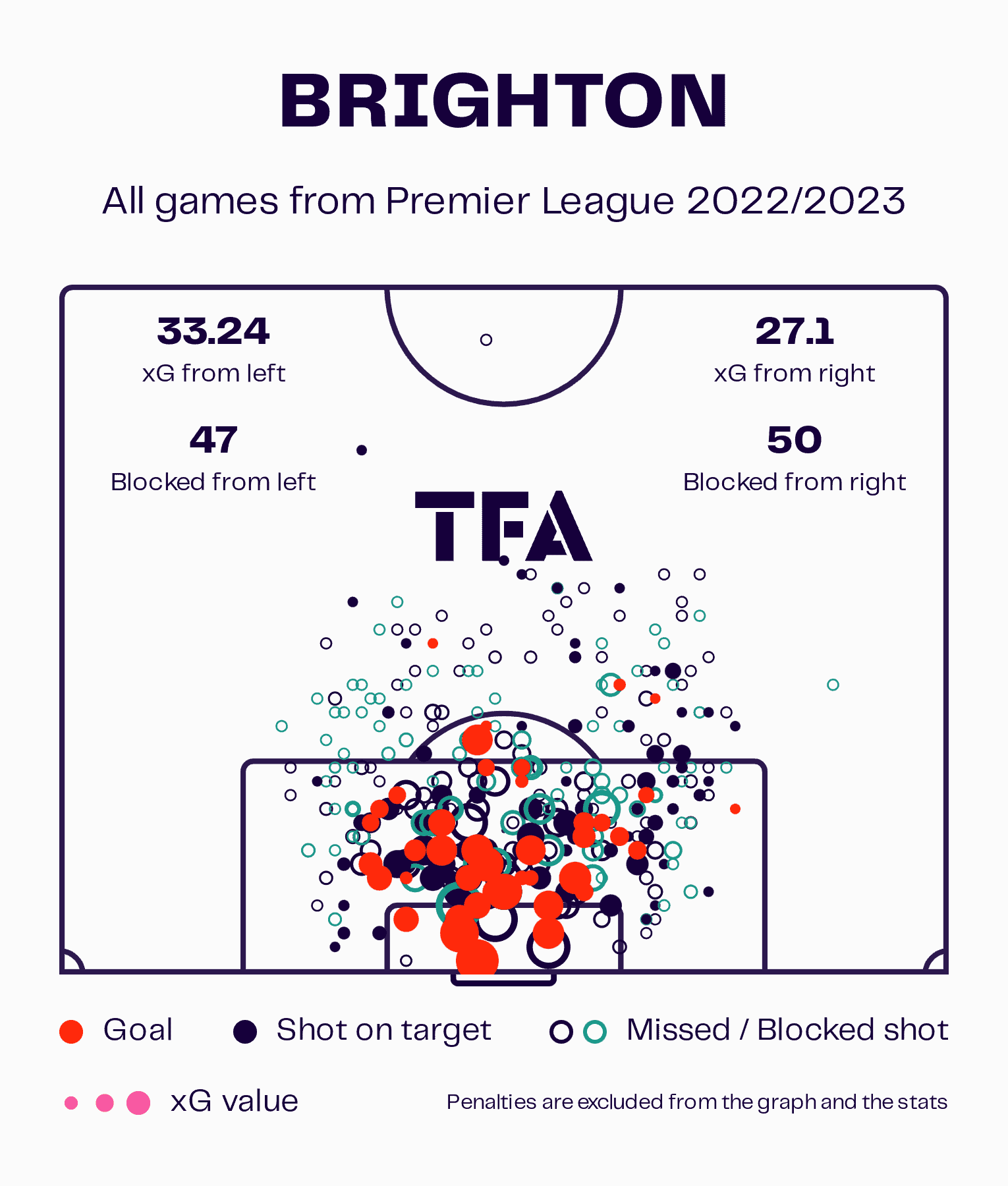
Something that Brighton do really well is recruitment, and they will have to really work overtime this summer with key player sales and European competition on the horizon.
The Seagulls have already sold arguably their best player from last season, with 24-year-old Argentine Alexis Mac Allister being sold to Liverpool for around €42m.
That likely will not be it with their midfield turnover, with Ecuadorian midfielder Moisés Caicedo linked with a big-money move to Chelsea.
With that said, the midfield area is likely where Roberto De Zerbi will look to strengthen, with this already happening with two free transfers, Mahmoud Dahoud from Borussia Dortmund and James Milner joining the club from Liverpool.
The Seagulls have also managed to strengthen in other areas, bringing in forward João Pedro from Watford and goalkeeper Bart Verbruggen from Belgian Pro League side Anderlecht.
Also, at the time of writing, Brighton have been linked with Fiorentina defender Igor Julio and Arsenal striker Folarin Balogun.
Using our xGOLD tool, we propose Brighton could look at Ezequiel Fernández from Boca Juniors as a potential replacement for Alexis Mac Allister with an 83% match.
This also would not be a surprising signing for Brighton if it did manage to happen, as the club are known to pluck young talents from South American football.
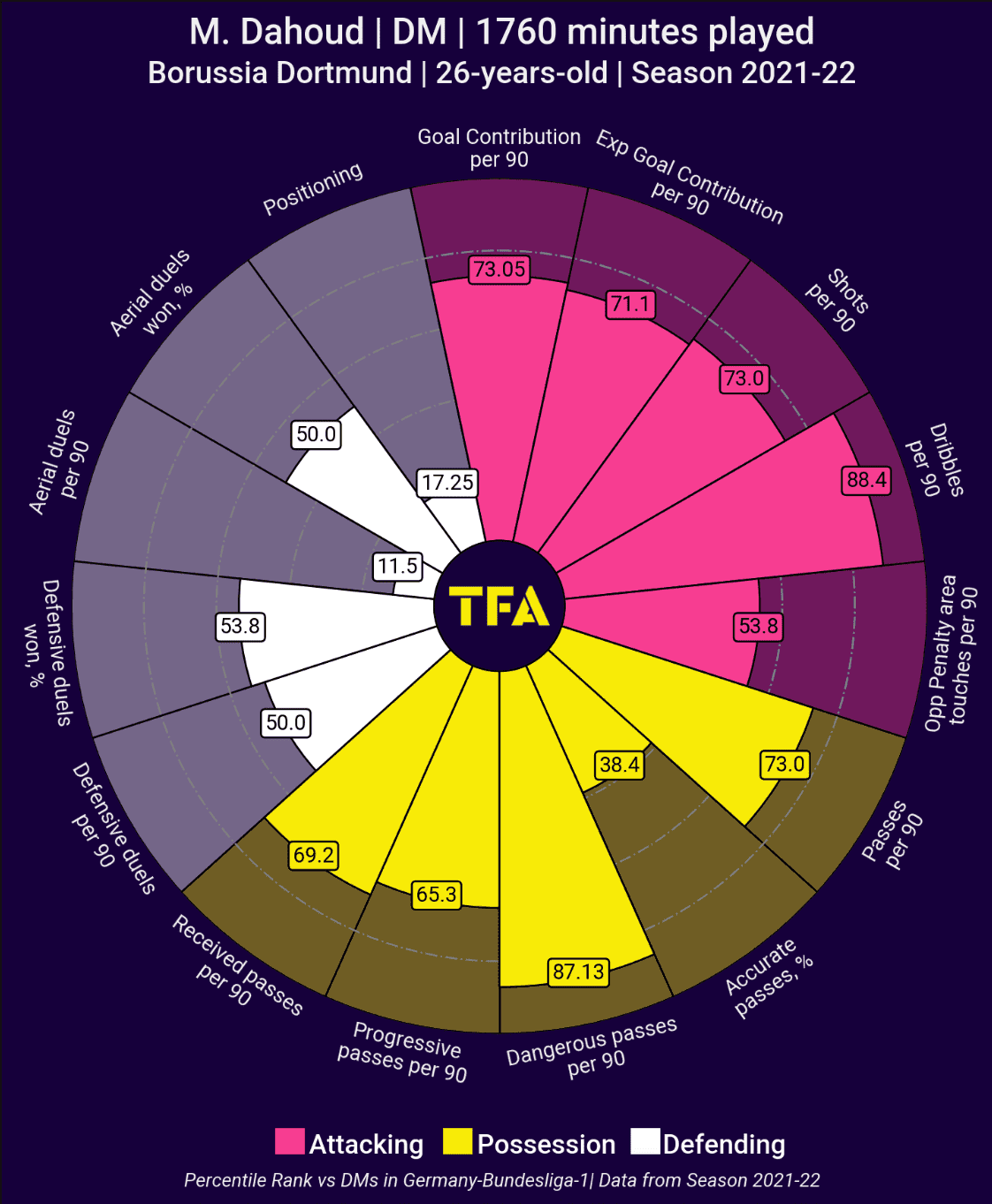
The graphic above shows a little of what Brighton fans can expect from one of their new signings, Mahmoud Dahoud.
The German midfielder joined from Borussia Dortmund on a free transfer and is an exciting player for De Zerbi, especially with the midfield turnover the south coast club is experiencing.
The pizza chart is from the 2021/22 Bundesliga season, as Dahoud only played in nine matches last campaign.
As we can see, Dahoud could potentially replace some of the attacking threat of Mac Allister, albeit from a deeper lying position, with the German ranking highly in both dangerous passes per 90 minutes and dribbles per 90, showing the attacking threat he could provide to De Zerbi’s side.
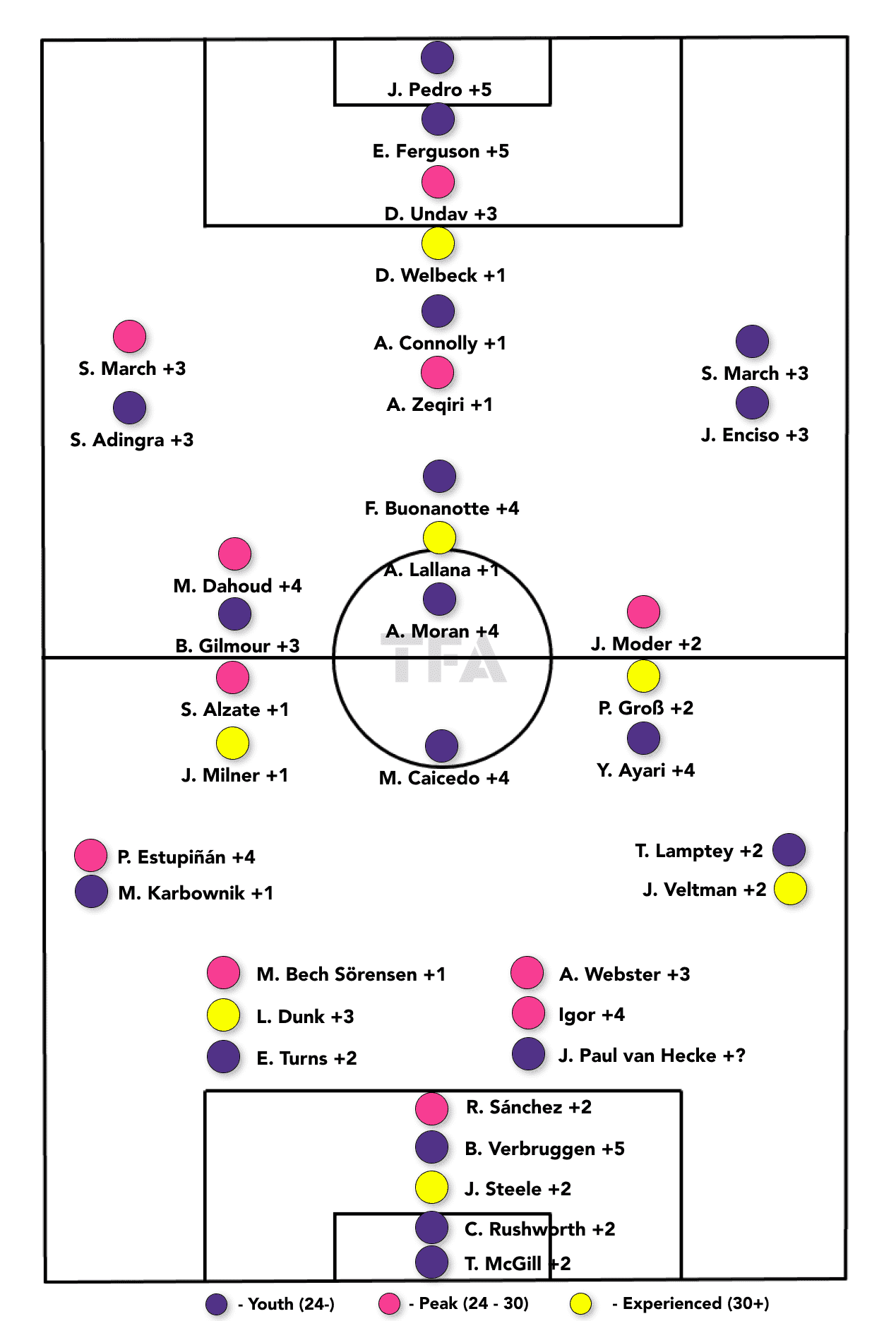
Attacking phase
When looking at the attacking phase of play for Brighton, this is where the tactics of Roberto De Zerbi really shine through.
The Italian looks to play possession-based football, with Brighton’s build-up play a constant talking point amongst many people.
However, as we’ll discuss in our scout report and tactical analysis, the other thing that De Zerbi’s side does well in the attacking phase is create space between the opposition lines, with Brighton always looking to have at least one free player between the lines in advanced positions.
The Brighton boss also looks to employ positional rotations during possession phases, with it being common for players to interchange positions and create space for the ball to be played into.
Essentially, De Zerbi looks for his side to be one step ahead of the opposition at all times when Brighton are in possession.
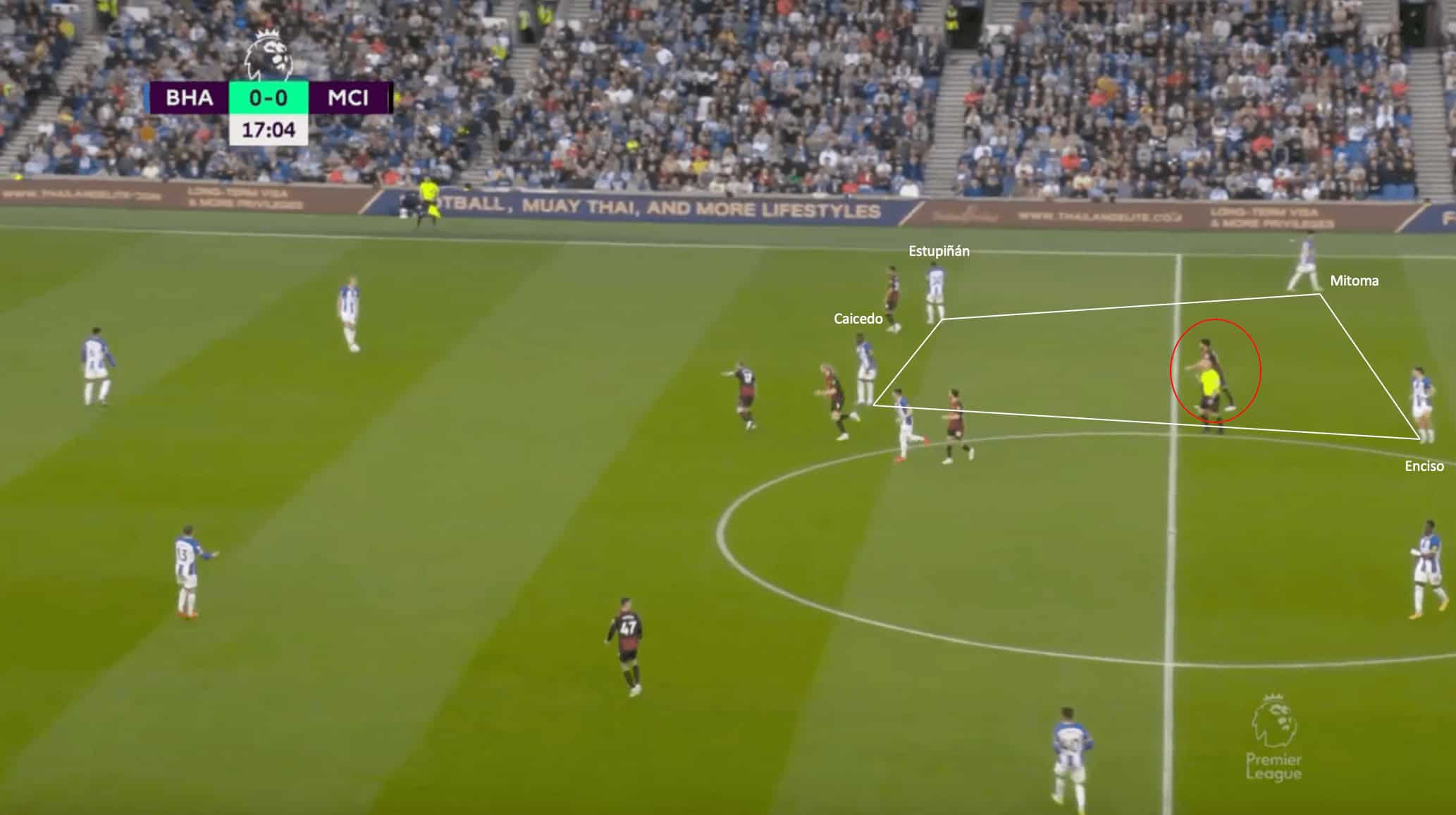
When Roberto De Zerbi’s Brighton are in possession and look to attack, they look to overload the wide areas of the pitch, creating space between the opposition’s lines to progress the ball into the attacking zones.
To kick off our analysis, an example from last season’s match against Manchester City is shown above.
The ball is in possession of the Brighton centre-back, while further up the pitch, Brighton have created an overload against Manchester City midfielder Ilkay Gündogan.
The German is isolated against the four Brighton attackers, with Estupiñán and Caicedo sitting behind the opposition’s press, while Mitoma and Enciso find space behind the Man City midfield line.
The situation is similar on the opposite side of the pitch, with the other advanced Brighton players able to locate space behind the Man City lines.
When Brighton’s centre-backs stop and put their foot on the ball to bait in opposition pressure, these players between the lines become prime targets for the defenders to find with line-breaking passes to break down an opposition’s press quickly.
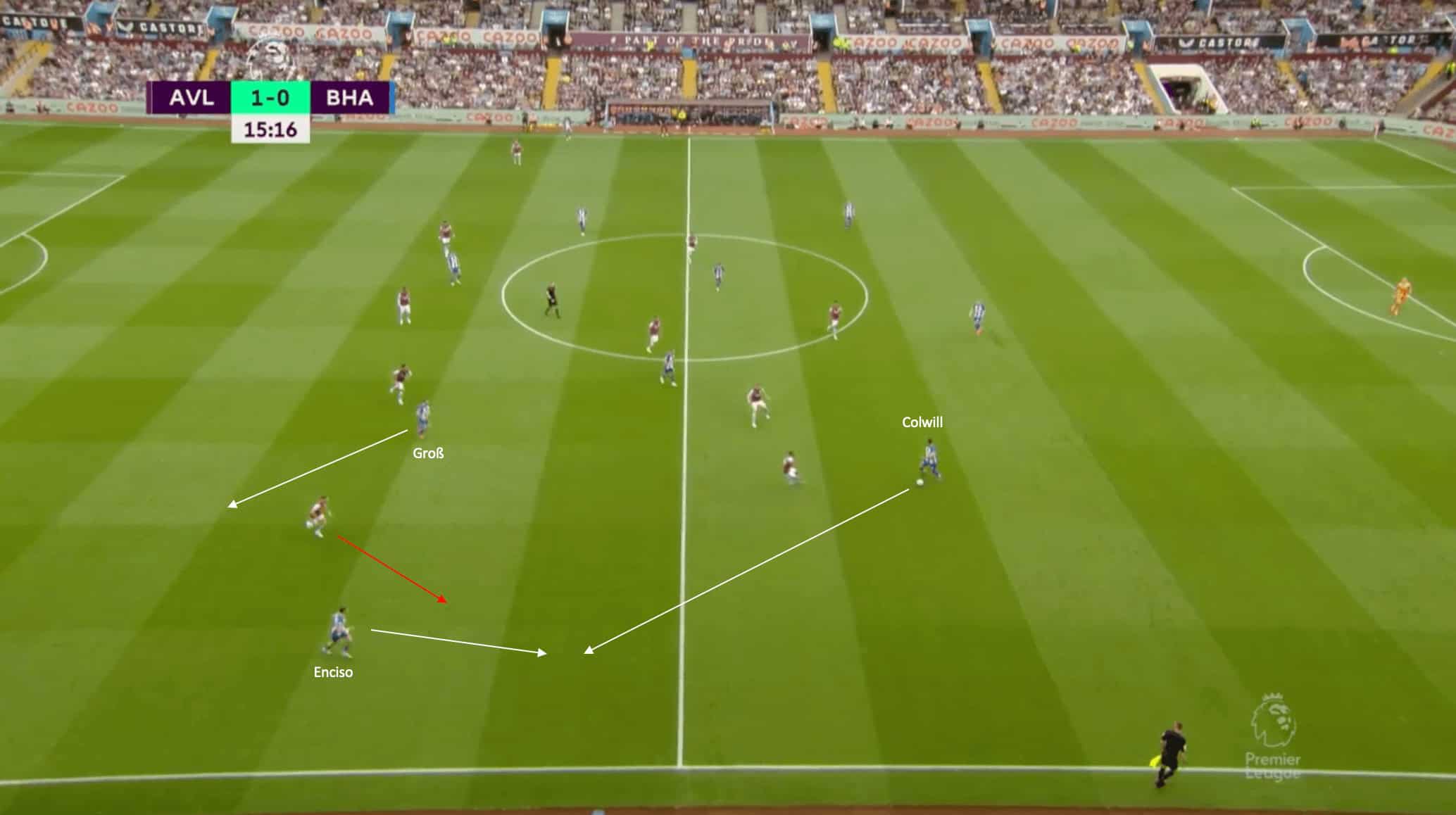
The image above shows another example of an overload and positional movement created by Brighton, resulting in the ball being progressed into the attacking third of the pitch.
In this phase of play above, Brighton central defender Levi Colwill receives the ball and puts his foot on it, looking to bait the Aston Villa pressers.
This occurs with the Villa forward looking to pressure Colwill and force an error.
However, the England international spots the movement of Julio Enciso, who finds himself in Pascal Groß’s wide-left position.
He drops to become an option for Colwill, with this dragging the opposition defender with him.
As a result, the space opened up for Groß to make a run into this near wide channel, with the fullback caught in a 2v1 against the Brighton attackers.
Because of this quick off-the-ball movement, Enciso can play a first-time pass to the German after receiving, with Groß gathering possession and driving into the attacking third before the ball goes out of play.
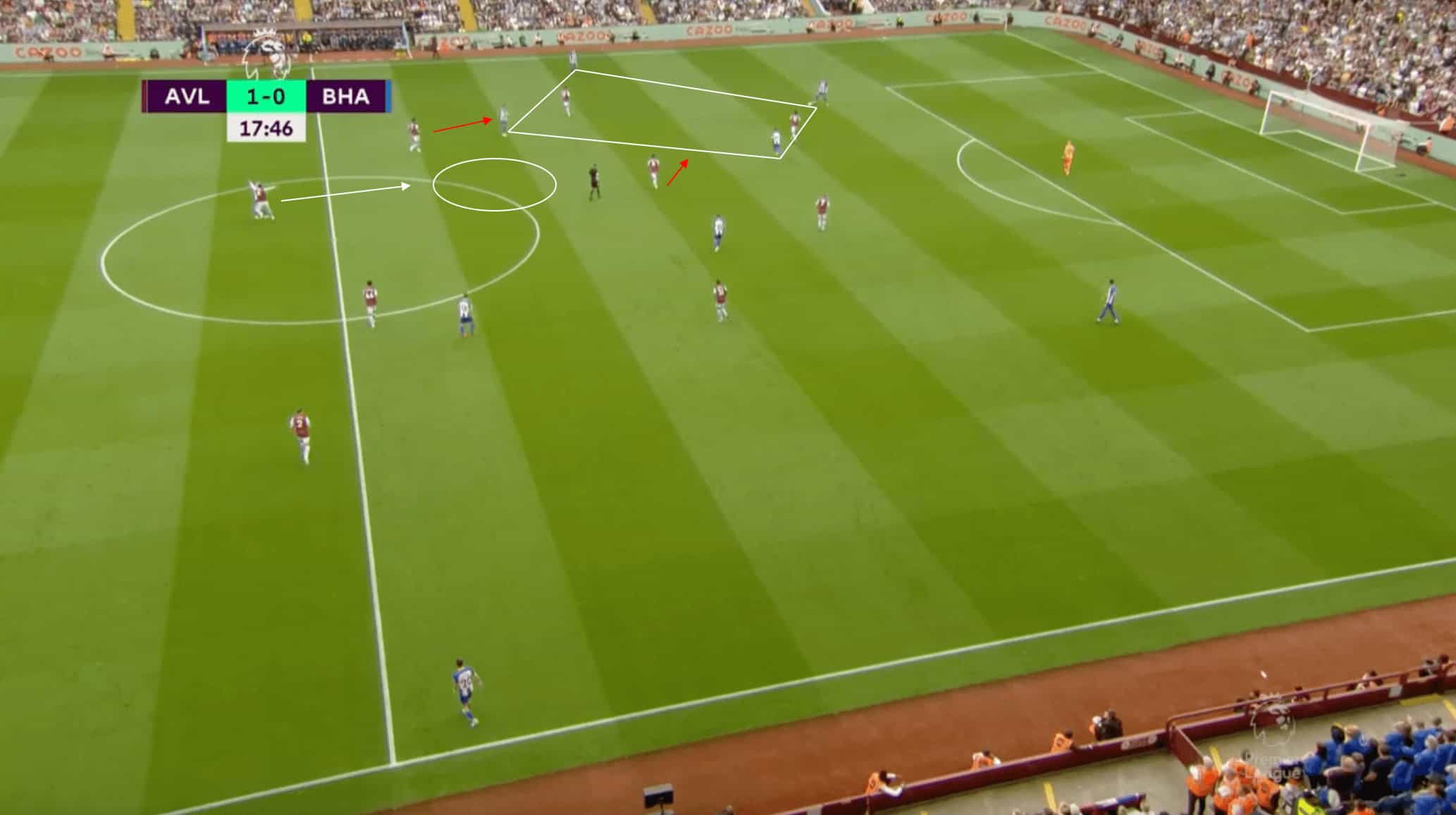
As the annotated image above shows, Brighton again look to create numerical advantages in the midfield areas by creating a diamond shape between the central defender in possession, the fullback, and the two midfielders who have dropped into this deeper position.
This shape gives the Seagulls a numerical advantage against the Villa defenders, allowing them to progress the ball through the diamond if necessary.
The closest Aston Villa players notice this, and they leave their zones to create a numbers-even situation against the diamond.
As a result, the space opened up between the Villa lines for the Brighton forward to drop into, with the ball played to him before being fouled and giving Brighton a free kick and a free chance to progress the ball into the attacking half.
Due to the positional movement and positioning of the Brighton players, a potentially dangerous situation to play the ball out of became a rather fruitful one.
As this section has highlighted, Roberto De Zerbi’s attacking principles worked wonders with this Brighton squad when he took over last season.
With the departures of some key players this summer, it will be interesting to see if the Italian potentially tweaks some of these tactics to better fit the new signings and current squad he has at his disposal, especially with the introduction of European football this season.
Defensive phase
When watching the defensive phase for Brighton under Roberto De Zerbi, a common trend stands out, looking to defend from the front and holding a high line when defending.
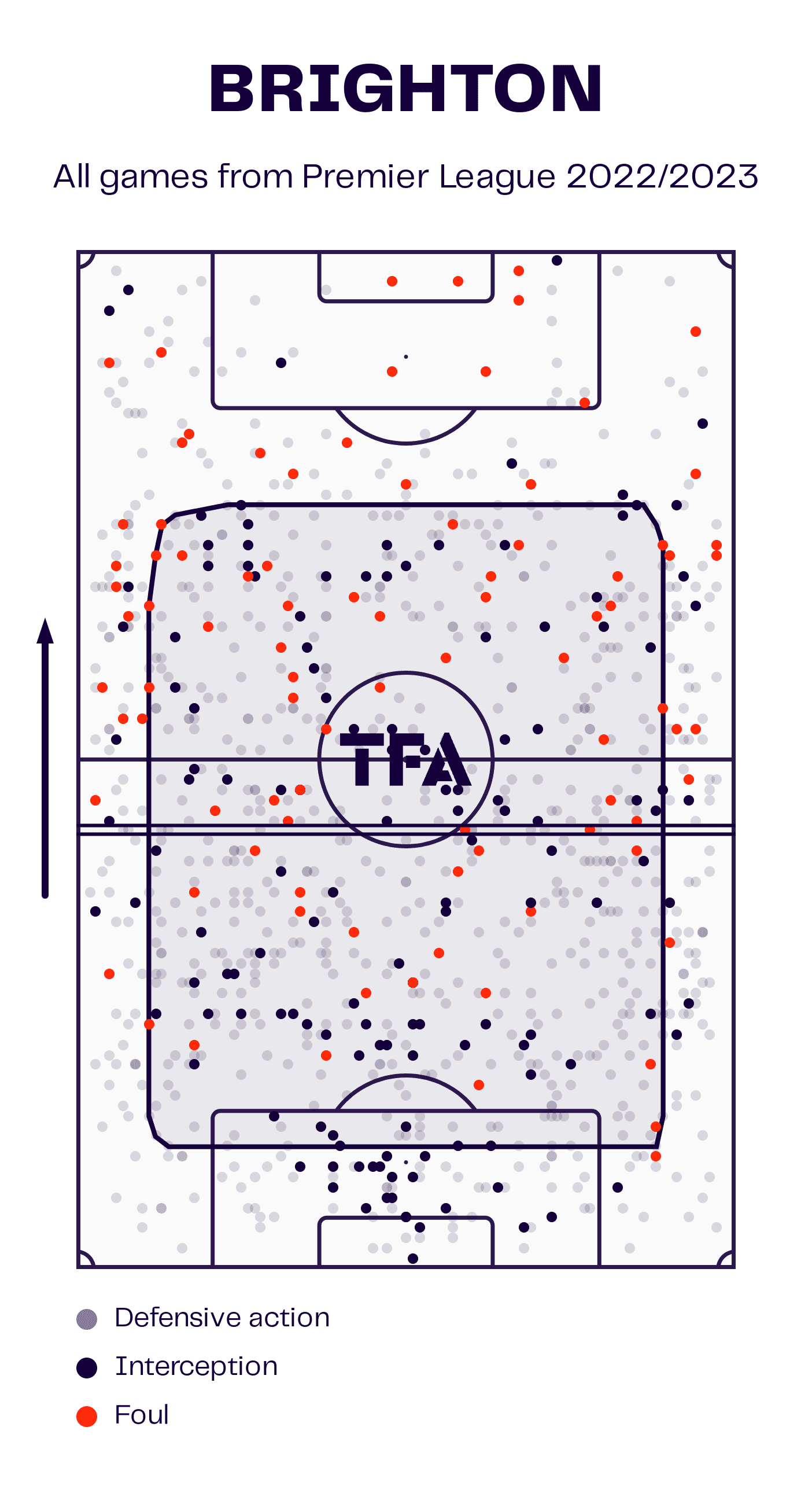
The data viz graphic above shows the defensive territory of Brighton last season under the Italian manager.
Two things stand out right away, the number of defensive actions that Brighton commit in the attacking third of the pitch and their average line of defensive engagement.
The Seagulls opt for a high-pressing defensive approach that can be considered a high-risk/high-reward style.
This can be highlighted by the number of goals Brighton conceded last season compared to the other sides that finished around them.
They shipped the most, which was counteracted slightly by the aggressiveness when they regained possession in these advanced areas.
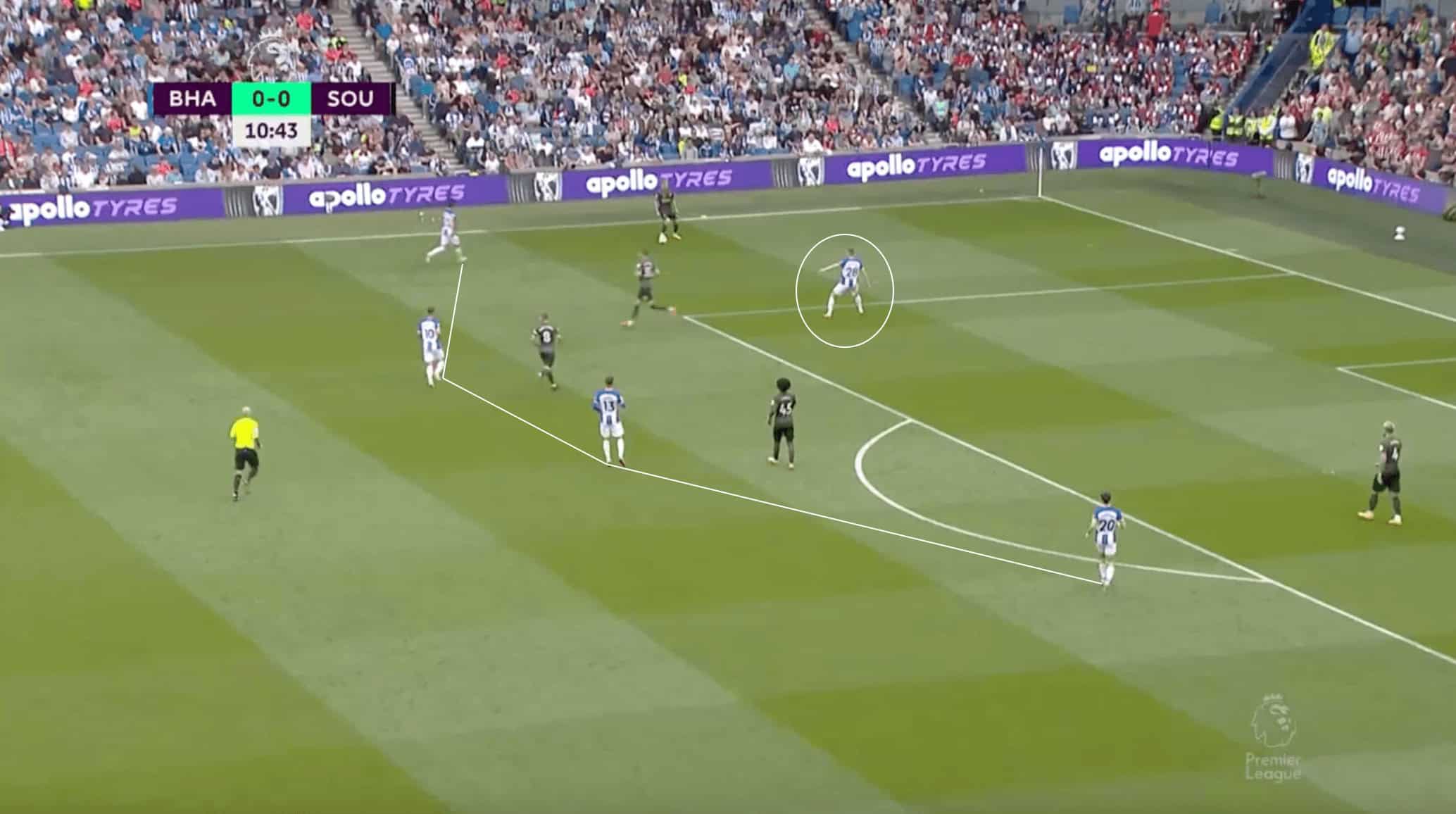
The image above shows how Brighton look to attack their opposition in defensive phases of play.
In this phase of play from last season’s match against Southampton, the Saints had just started building out from the back, with the ball coming wide from the goalkeeper.
As the Brighton forward puts the goalkeeper under pressure, the ball is played to its current position on the far touchline.
Now, Brighton look to suffocate their opposition and lock the ball into one side while also creating a wall along the 18-yard box so they could have pressure on the opposition side if the ball is switched.
However, Brighton could potentially get exposed if opposition sides can play through this first line of pressure.
However, with the aggressive nature of the pressing and ability to lock the opposition into one side of the pitch, it allows De Zerbi’s side many opportunities to win the ball back in advanced areas and embark on quick counterattacking moves due to the number of players they commit forward in these defensive phases.
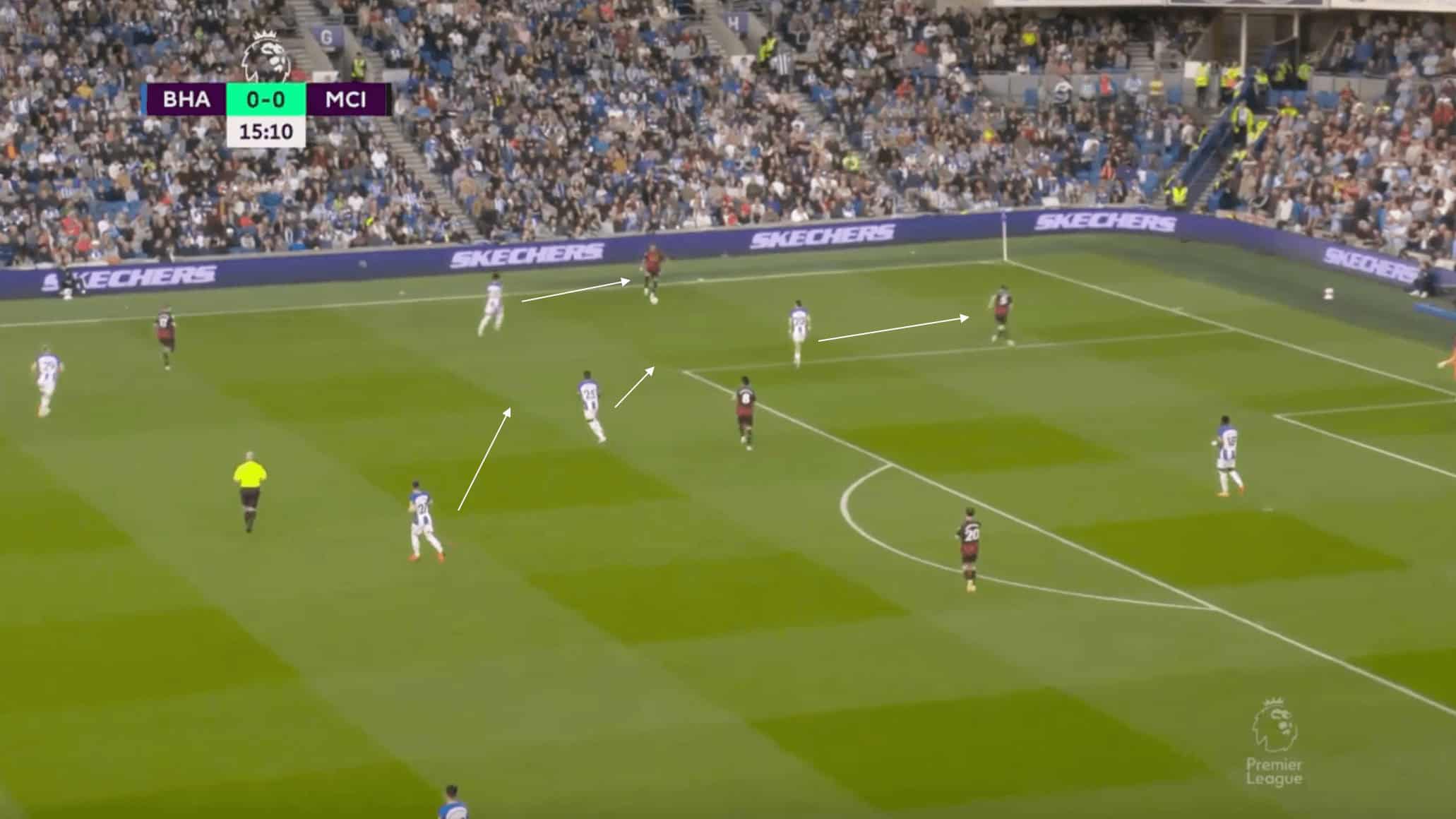
Another example of the pressing in the defensive phase from Brighton is shown above from their match against Manchester City last season.
As in the previous example, this phase began with a goal kick from Manchester City, with Brighton forcing the ball to one side again.
As we can see, the Brighton players near the ball all shift towards this side, locking the ball into one side and being well-positioned for transitional moments.
When the ball reaches the player in the wide area, the closest Brighton player puts him under immediate pressure.
This pressure results in a change of possession, though only for a short period.
Though Brighton could not retain the ball that they won in this defensive phase, it still shows what De Zerbi asks of his side in the defensive phases of play: immediate pressure on the ball to win back possession as soon as possible.
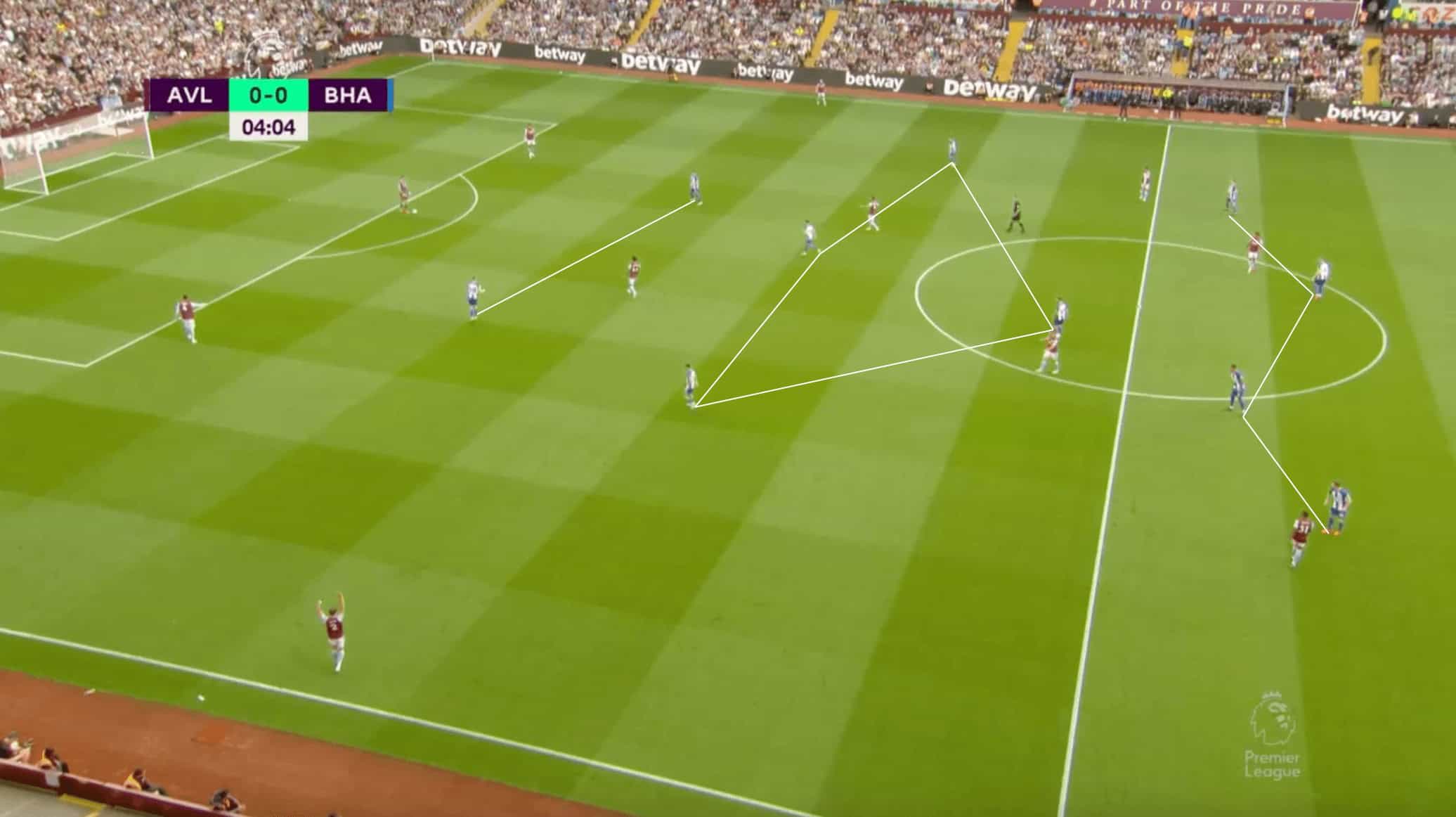
At the beginning of this section, the data viz graphic showed the average height of Brighton’s backline, averaging just inside their half.
An example of this aggressively high line is shown in the image above, with Brighton operating in a 4-1-3-2 shape out of possession.
This high positioning of the defenders again goes back to how De Zerbi likes for his side to defend from the front and press in these defensive phases.
This will likely remain the same campaign, so watch for Brighton to be very aggressive and on the front foot often in defensive phases of play, even against superior opposition.
Transition phase
Being that Roberto De Zerbi likes to play a possession-oriented brand of football, some may not think of Brighton as a side that excel that much in transitional attacking moments.
However, this is not the case.
This links well with how they like to press high up the pitch in the defensive phase to win possession back and look to transition.
In these defensive moments, the Seagulls are looking to regain possession and counter with numbers, catching the opposition’s defenders out of position in advanced areas.
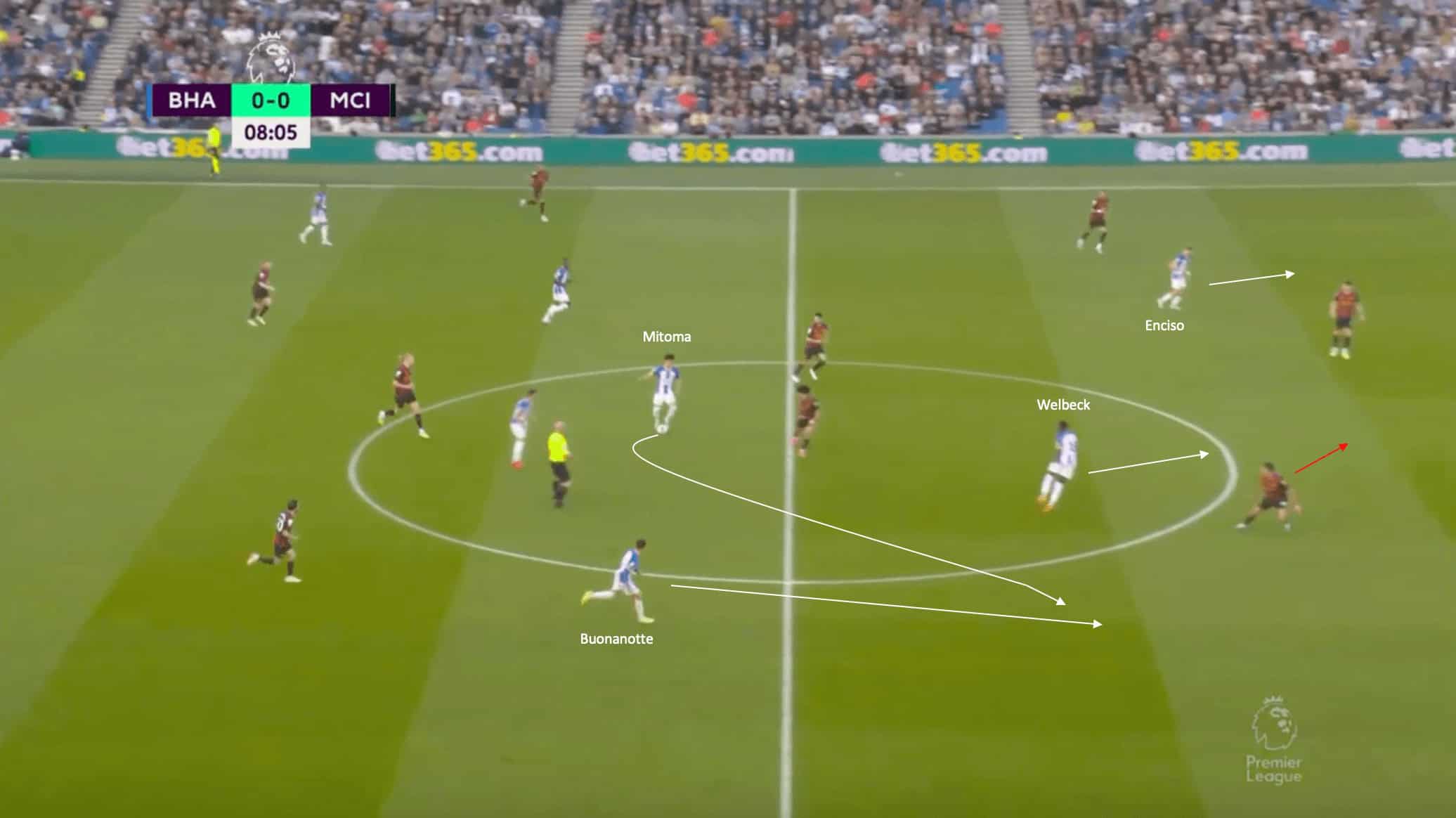
The image above shows an example of how Brighton look to attack in transition when they win possession in the midfield areas.
In this phase of play above, Kaoru Mitoma tracks all the way back to win possession just inside the Brighton defensive half.
They then look to counterattack quickly, with De Zerbi’s side wanting to get numbers forward into the danger areas where the opposition is out of position.
This is exactly what happens with the run of Facundo Buonanotte, with the young midfielder able to exploit the space left vacant by the Man City fullback, who has tucked inside to form a box midfield.
Mitoma can play the ball out wide to the feet of the Argentine attacker, with Danny Welbeck and Julio Enciso also in favourable attacking positions.
Brighton look to exploit the wide areas when they hit in transition, with this typically being where they can find the space from the opposition fullbacks being pushed into advanced positions.
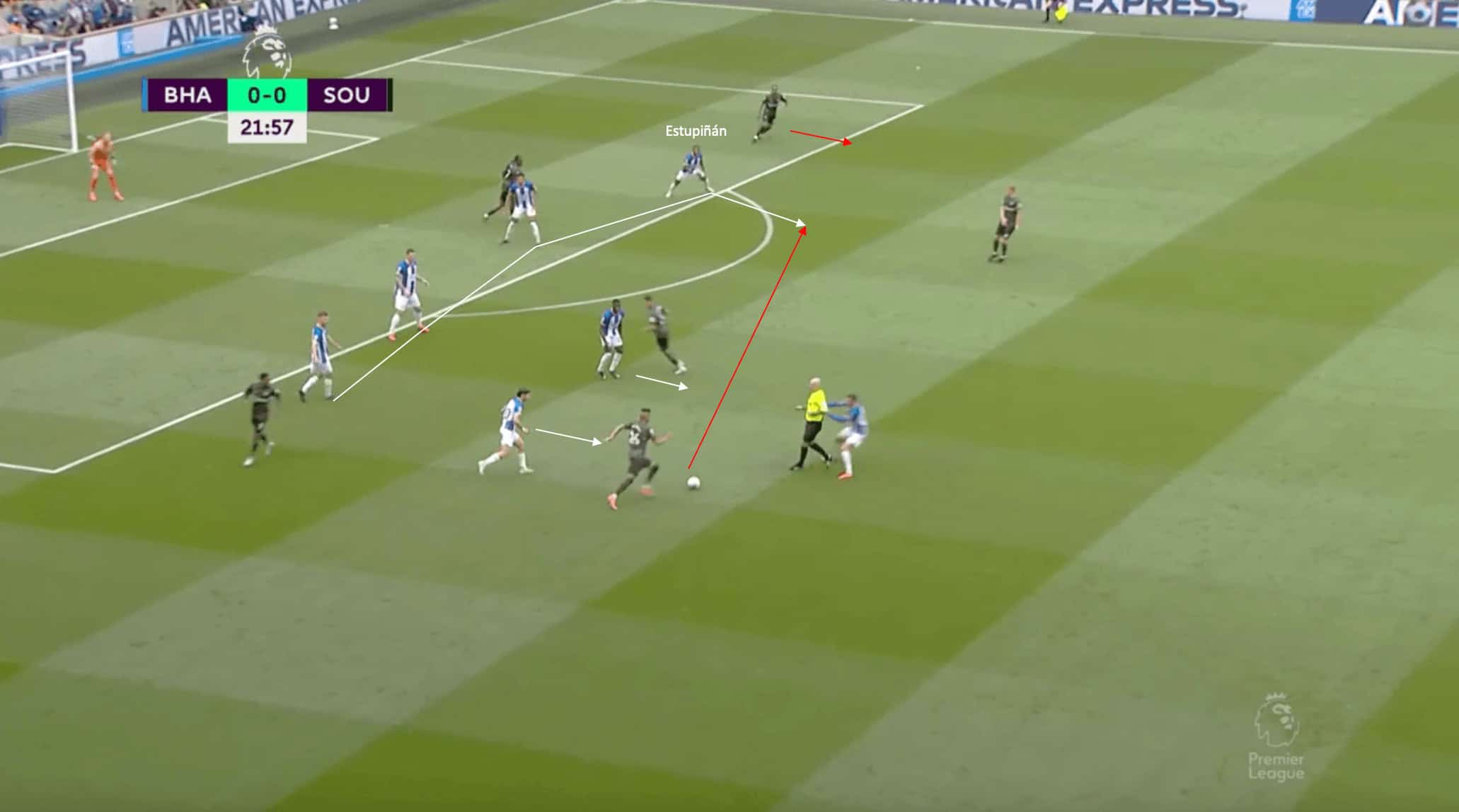
The image above shows how Brighton look to play in defensive transitional moments.
With Brighton usually playing free-flowing attacking football, in defensive transitional moments, the south coast side look to drop off and defend compactly when the opposition reaches their 18-yard box off of a turnover.
In the phase of play above from their match against Southampton last season, the Saints had won the ball back in the midfield area off of Brighton, with the Seagulls forced to drop off and defend.
As we can see from the image, Brighton look to get tight and compact with their back four in these transitional moments, with the midfielders looking to put pressure on the ball and force the ball carrier into either a poor touch or poor pass.
The latter is what happens above.
The only progressive option for Southampton is to try and play a switch of field ball to the opposite side of the penalty area, looking for the winger positioned on the back shoulder of the fullback, Pervis Estupiñán.
The Ecuadorian, however, is able to read this pass, with him jumping the passing lane as the ball is being played and winning possession back for Brighton, negating any potential danger and allowing Brighton to start an attacking phase of play again.
Under Roberto De Zerbi, Brighton look to play quickly in the transitional attacking phases of play.
In contrast, they are fearless in sitting back and defending in a compact shell during transitional defensive phases of play.
Is João Pedro the #9 Brighton have been waiting for? What could this mean for Evan Ferguson?
For the past few seasons now, Brighton have been searching for the player who could become their #9 of the future.
Recently, Danny Welbeck has managed to do a decent job when called upon, but the Englishman is not the future up top for the Seagulls.
Then, in the summer of 2022, Tony Bloom raided his other club to sign German striker Deniz Undav from Union Saint-Gilloise after he scored 45 goals in total during his two seasons in Brussels.
So far, his time in England has been mixed, with only eight goals scored in 30 appearances in all competitions for Brighton last campaign.
18-year-old Republic of Ireland international forward Evan Ferguson was likely who many Brighton fans would have tipped for that honour after he scored 10 goals for the club in all competitions last campaign.
However, Brighton went out and spent a large portion of money on João Pedro from Watford, a fee that is reported to be in the region of £30m, a club record fee.
With Ferguson linked to clubs like Manchester United in the past, maybe Brighton are potentially preparing for his inevitable departure.
Or is it just that Brighton believe the Brazilian is the #9 the club has been missing?
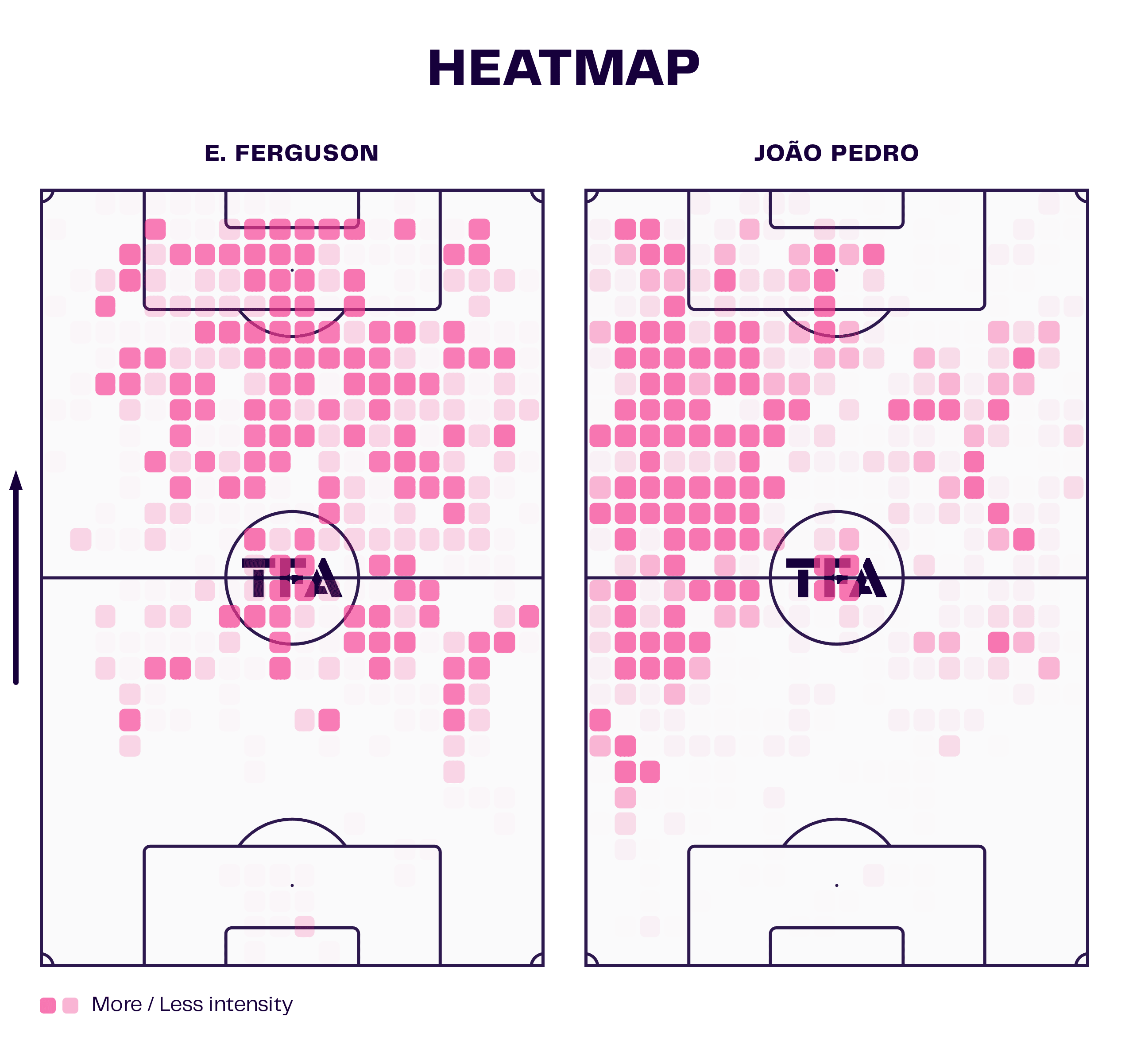
The data viz graphic above shows the heat maps of both Pedro and Ferguson from their league play last season.
As we can see, the Irishman had more impact in and around the penalty area, while Pedro tends to drop into deeper midfield positions or drift wide left.
It could be possible that De Zerbi plays the two together, as he has tended to use a 4-4-2 with Brighton during his time in charge of the club.
This is the preferred outcome for Brighton fans, as De Zerbi would have two strikers with different skill sets at his disposal.
In a 4-4-2 with Pedro and Ferguson, the Irishman could be the target man, something he excels at, while Pedro is a forward more inclined to drop deep and link play together.
This section will look at some examples of how João Pedro plays and how he could mesh with Ferguson’s target man style of play.
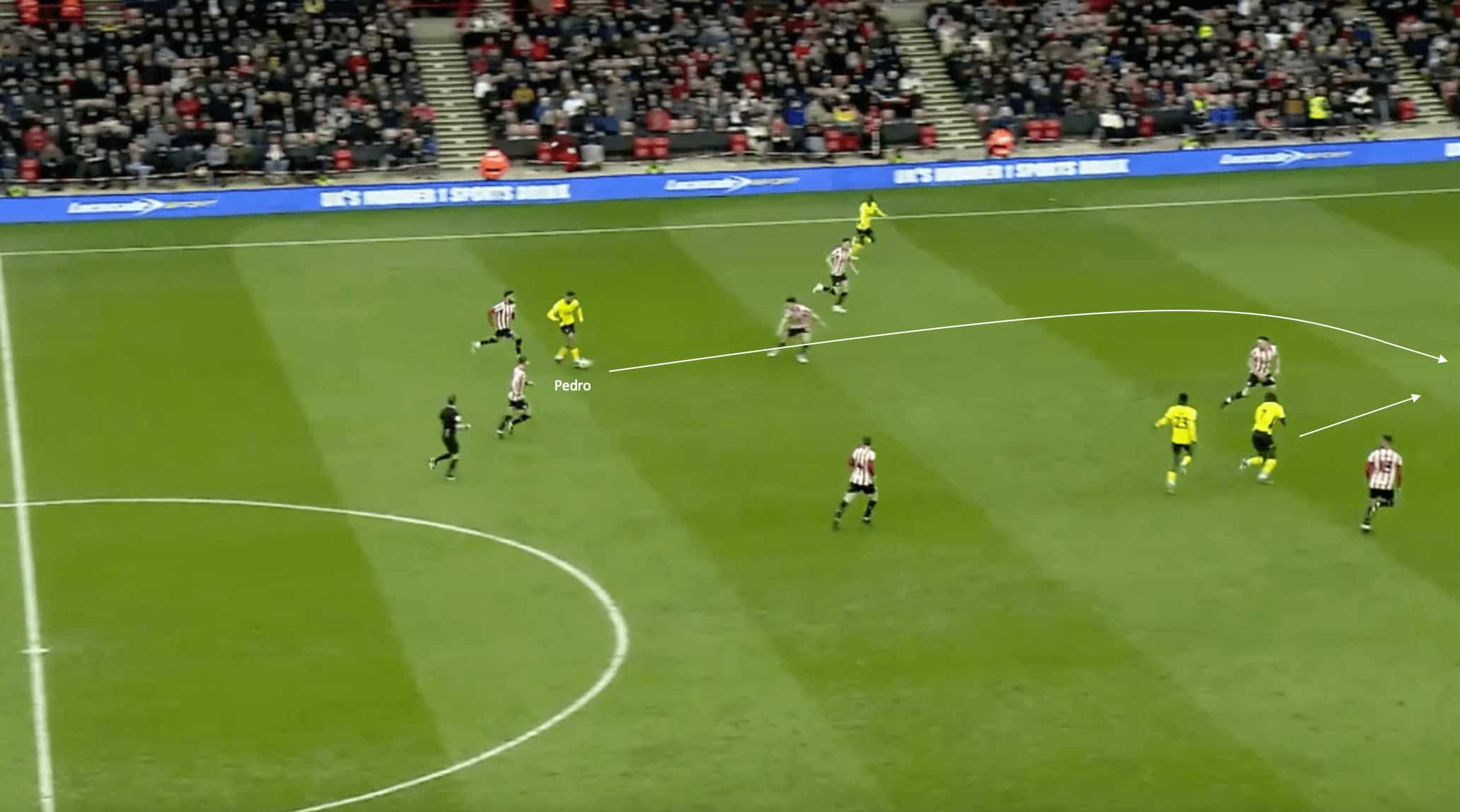
One trait João Pedro will bring to Brighton that differs from what Evan Ferguson offers is the passing ability and vision of the Brazilian, as well as his ability to drop into pockets of space in midfield to progress play.
In fact, the 21-year-old averages 36.28 passes per 90 minutes, with a success rate of 76%.
In the phase of play above, the Brazilian forward has dropped into a deeper area, looking to get onto the ball and progress it to his teammates beyond him.
After receiving the ball in this area, Pedro spots the run of the forward and plays a line-breaking pass beyond the opposition defence and into the path of the forward.
This could be something that Brighton fans see rather often next season, just with Evan Ferguson being on the end of the pass to potentially slot home.
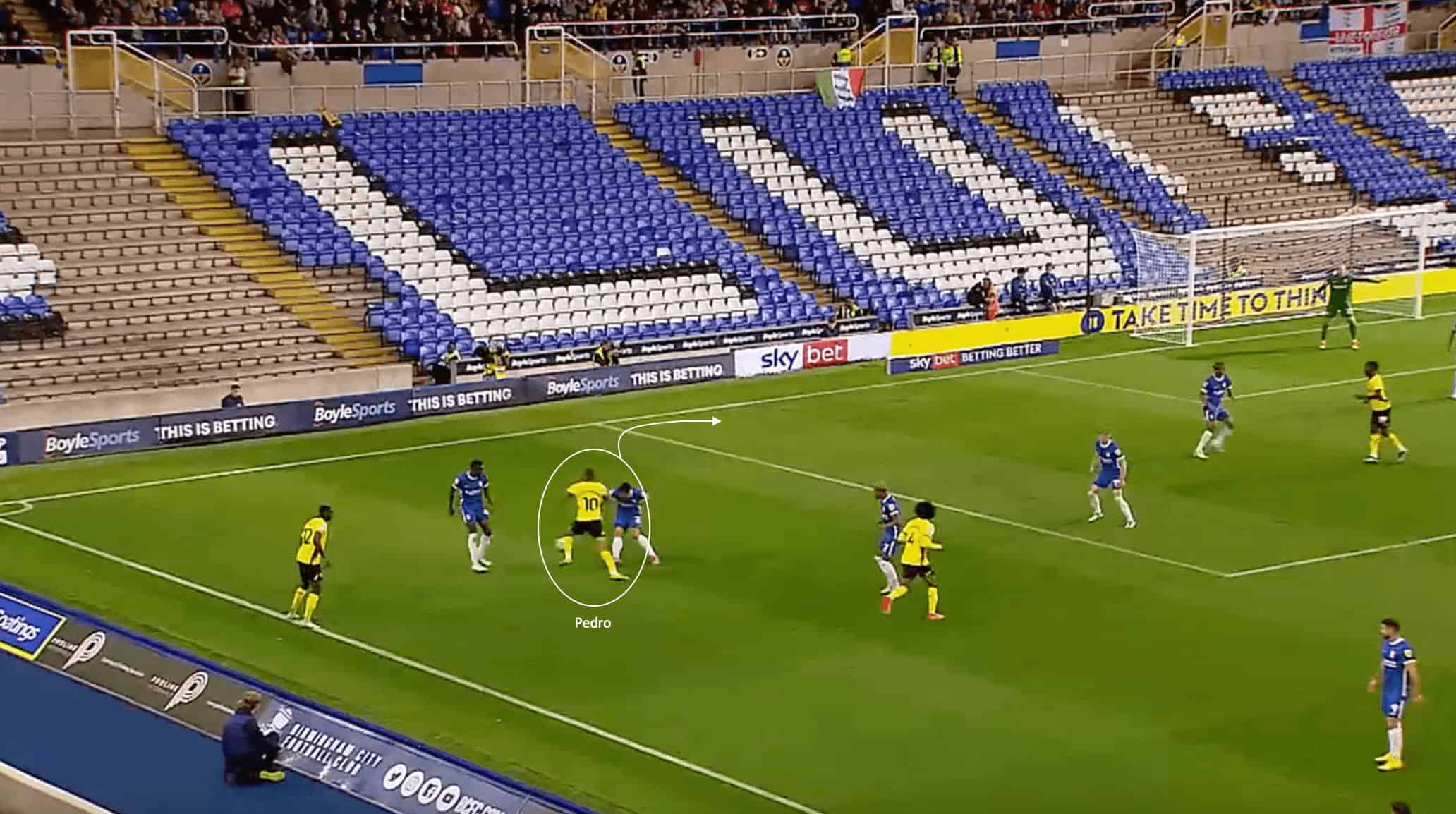
Another trait João Pedro brings to the table is his positive dribbling ability, with the Brazilian forward a somewhat capable dribbler in and around the penalty area.
The 21-year-old averaged 7.67 dribbles per 90 minutes in the Championship last season, with a success rate of 52.1%.
In this phase of play above, Pedro is positioned on the left side of the attack, which he does rather often.
With two defenders engaging and looking to pin him in, the Brazilian used his trickery to get past the defenders.
He used his close control and dribbling to send the ball past the defenders and into space before running back onto the loose ball.
He then was able to send a ball across the box and towards the positioning of the target man, the role that Ferguson would likely play for De Zerbi next season.
Under the Italian tactician next season, João Pedro is likely going to play a prominent part, and it may not be as a replacement for Evan Ferguson but rather as a partner to the 18-year-old Republic of Ireland international.
Both young forwards have differing skill sets, and it would be wise for De Zerbi to potentially utilise both to their strengths, with this potentially allowing a strong Premier League striking partnership to form next season.
Key player: Kaoru Mitoma
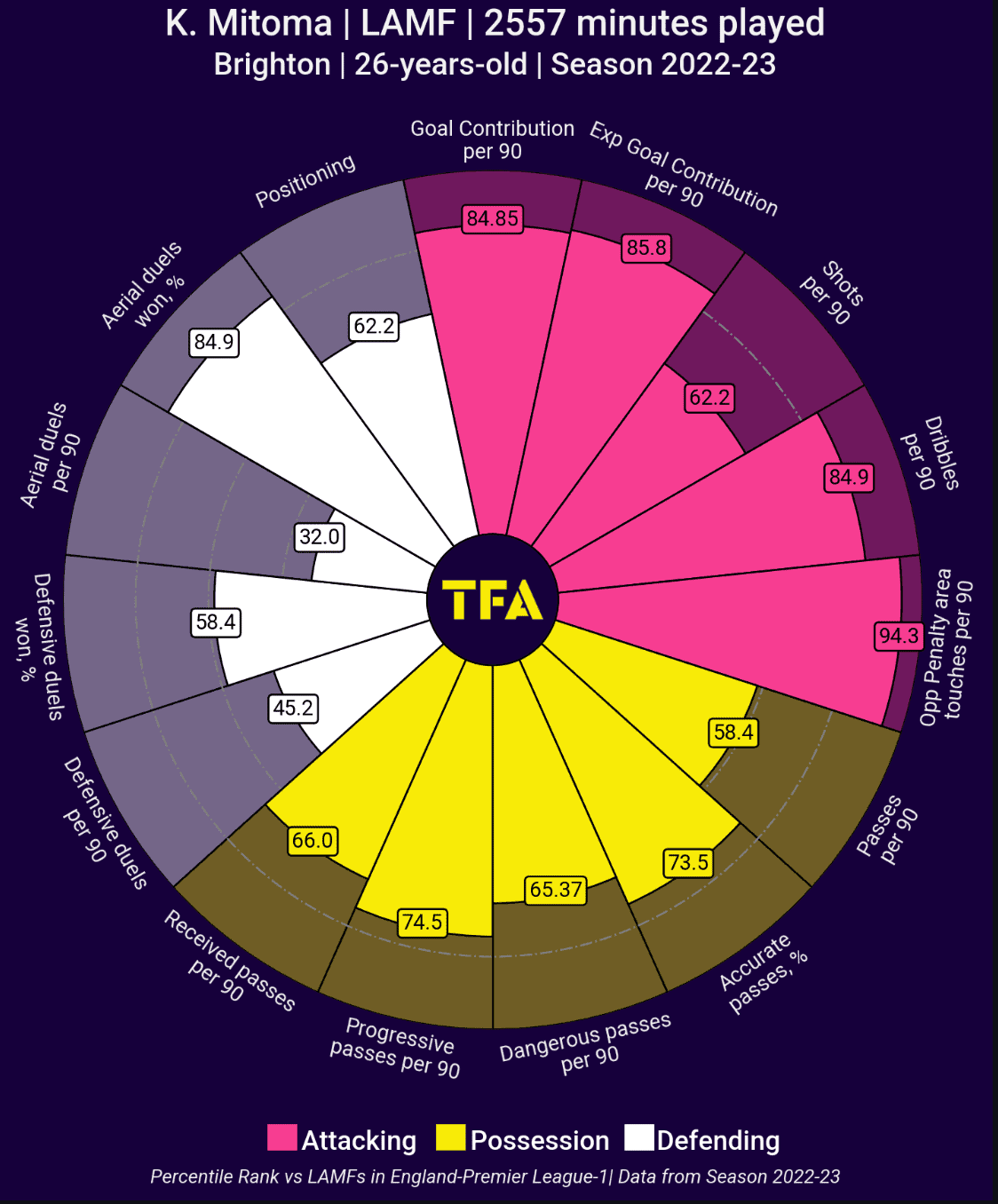
When it comes to picking a key player for Brighton next season, it is hard to look past Japan international Kaoru Mitoma.
The 26-year-old had a spectacular season for the Seagulls last campaign, with seven goals and five assists to his name.
Compared to other left-sided attacking midfielders in the Premier League last season, Mitoma ranked very highly in the attacking metrics, showing the danger he can create.
The Japan international ranked above the 80th percentile in every attacking metric barring shots per 90, showing his ability in and around the penalty area.
While Mitoma is not the most dangerous passer when it comes to other midfielders like him, his attacking metrics are where he stands out, with Mitoma likely playing an even more significant role for De Zerbi next season, especially with the added task of handling European football.
Mitoma is the very definition of a tricky winger, one that Brighton will be thrilled will be sticking around for another season at least.
One to watch: Julio Enciso
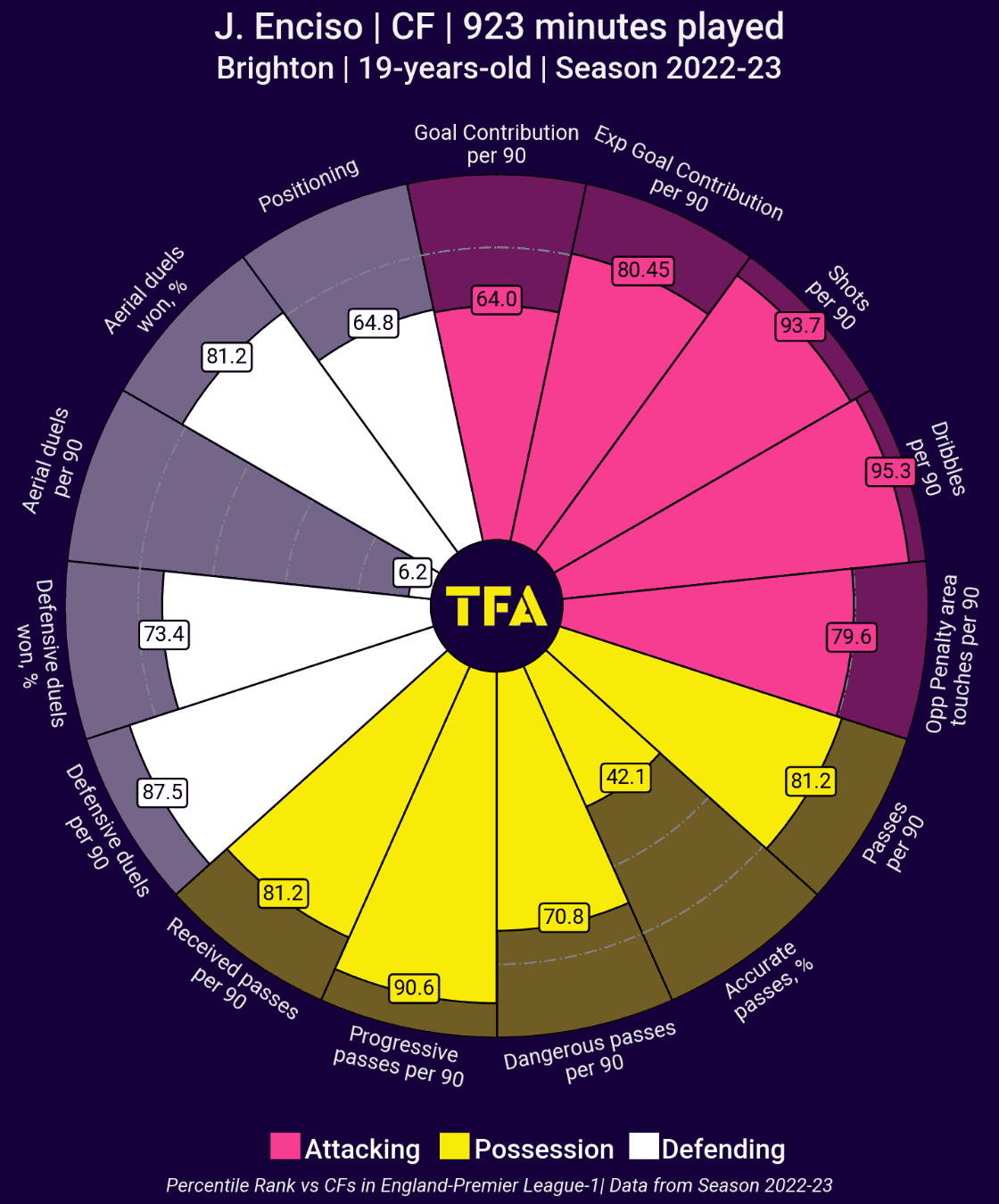
With the departure of Alexis Mac Allister to Liverpool this summer, 19-year-old Paraguayan attacking midfielder Julio Enciso will likely take on a more prominent role next season with the departure of the Argentine.
Though he played under 1,000 minutes last campaign, Enciso started to feature heavily for Brighton in the second half of the season under De Zerbi.
Looking at the Paraguayan’s metrics, a few stand out instantly.
Firstly, he ranked in the 95th percentile for dribbles per 90, showing his ability to successfully take opposition defenders on with the ball at his feet.
He also ranks in the 90th percentile for progressive passes per 90 minutes and above the league average for dangerous passes per 90.
With Mac Allister’s departure leaving a large hole in attacking midfield for Brighton, Julio Enciso will be one to watch this season, with him being one of the players De Zerbi will rely on to replace the impact that Alexis Mac Allister had on the Brighton attack last season.
TFA Verdict: 8th
Aim #1 has to be to challenge for Europe and aim #2 is to make sure they don’t lose RDZ mid-season.
The Premier League’s ‘cleverest’ club will need all that intelligence to manage a European campaign whilst pushing on in the league but it will be fun to see their next generation come through and look like absolute world-beating business once again.

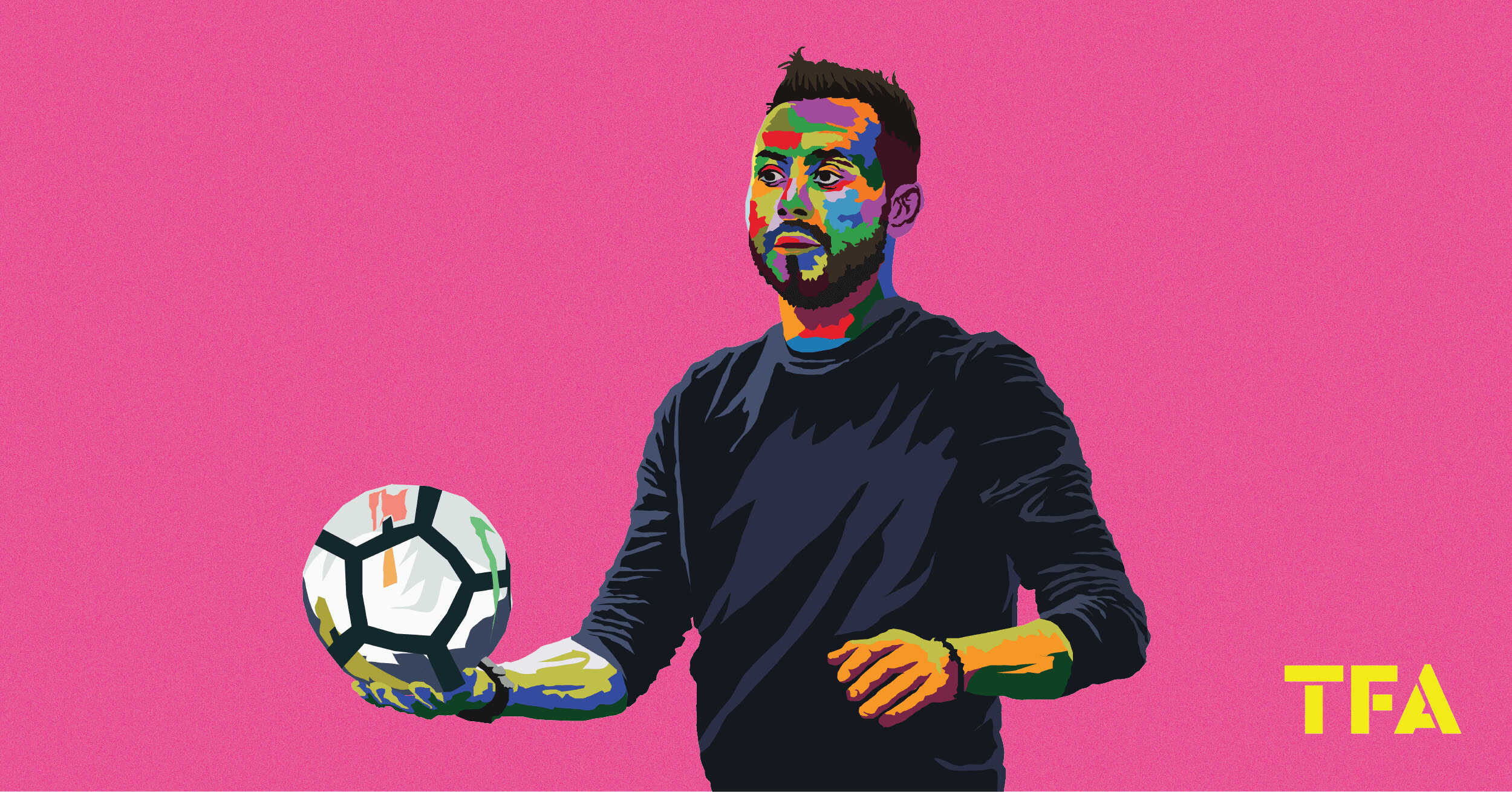



Comments